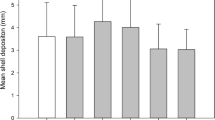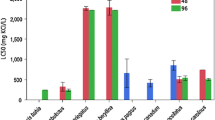Abstract
Chlorothalonil is a fungicide whose heavy use in eastern Canada gives it the potential for significant aquatic contamination. Laboratory bioassays and field treatments of a pond system were undertaken to determine the toxic effects of Chlorothalonil on aquatic fauna. The 96-h LC50 of technical Chlorothalonil for rainbow trout (Oncorhynchus mykiss) was 76 μg/L and was not significantly different (p < 0.05) from that of the formulated product (Bravo® 500). The 96-h LC50 of Bravo 500 for blue mussels (Mytilus edulis) and clams (Mya arenaria) was 5.9 mg/L and 35.0 mg/L respectively, while its 48-h LC50 toDaphnia magna was between 130 μg/L and 200 μg/L. Chlorothalonil exposure ofDaphnia to concentrations as low as 32 μg/L significantly (p < 0.05) increased the time to production of first young, but there were no delayed effects on number of young produced or growth at concentrations of 180 μg/L or less. Chlorothalonil was initially accumulated by blue mussels to concentrations approximately ten times greater than exposure concentrations; however, tissue concentrations returned to the same level as exposure concentrations within 96 h. Spraying of ponds resulted in mortality of caged water boatmen (Sigara alternata) and threespine stickleback (Gasterosteus aculeatus) which could be related to chlorothalonil exposure, however, caddisfly larvae (Limnephilus sp.), freshwater clams (Psidium sp.), water beetles (Haliplus sp.), scud (Gamarus spp.) and midge larvae (Chironomidae) did not suffer substantial chlorothalonil-induced mortality. Changes in endemic benthic invertebrate abundance after sprays were not remarkable or related to treatment. Faunal impacts in the pond were generally of a smaller magnitude than were predicted by bioassay results. Factors such as dilution, adsorption to suspended particles and microbial degradation are thought to have attenuated the initial pond concentrations of Chlorothalonil, thereby reducing their toxicity.
Similar content being viewed by others
References
Bodar CWM, Van Leeuwen CJ, Voogt PA, Zandee DI (1988) Effect of cadmium on the reproduction strategy ofDaphnia magna. Aquat Toxicol 12:301–310
Coleman MJ, Hynes HBN (1970) The vertical distribution of the invertebrate fauna in the bed of a stream. Limnol Oceanog 15:31–40
Davenport J (1977) A study of the effects of copper applied continuously and discontinuously to specimens ofMytilus edulis (L) exposed to steady and fluctuating salinity levels. J Mar Biol Assoc UK 57:63–74
Davies PE (1988) Disappearance rates of chlorothalonil (TCIN) in the aquatic environment. Bull Environ Contam Toxicol 40:405–409
Davies PE, White RWG (1985) The toxicology and metabolism of chlorothalonil in fish. I. Lethal levels forSalmo gairdneri, Galaxias maculatus, G. truttaceus andG. auratus and the fate of 14C-TCIN inS. gairdneri. Aquat Toxicol 7:93–105
Dixon WJ (1970) Biomedical Computer Programs. University of California Press, Berkeley, California, 600 pp
Doe KG, Parker WR, Ernst WR, Horne WH (1983) Studies on the toxicity of Matacil® 180 F concentration, its formulations, and their components to aquatic fauna. Environmental Protection Service, Environment Canada, Surveillance Report EPS-5-AR-83-1
Doe KG, Wells PG (1978) Acute aquatic toxicity and dispersing effectiveness of oil spill dispersants: Results of a Canadian oil dispersant testing program (1973–1977). In: McCarthy LT Jr. Lindblom GP, Walter HF (eds) Chemical Dispersants for the Control of Oil Spills. American Society for Testing and Materials, ASTM STP 659, pp 50–65
Eidt DC, Hollebone JE, Lockhart WL, Kingsbury PP, Gadsby MC, Ernst WR (1989) Pesticides in forestry and agriculture: Effects on aquatic habitats. In Nriagu JO, Lakshminarayana JSS (eds). Aquatic Toxicology and Water Quality Management. John Wiley and Sons, Toronto, pp 245–283
Ernst WR, Doe KG (1990) A comparison of the aquatic toxicity of fenitrothion flowable and fenitrothion emulsion formulations. Water Pollut Res J Can 24(4):553–568
Ernst WR, Maguire RJ, Carey JH, Julien GR, Hart JH, Tkacz RJ, Lee HB (1989) The fate, persistence and biological impacts of deltamethrin applied directly to an agricultural pond system and the protection from deposit afforded by a 100 metre set-back. Environment Canada Surveillance Report. EPS-5-AR-89-1
Fairchild WL, Eidt DC, Weaver CA (1987) Effects of fenitrothion insecticide on inhabitants of leaves of the pitcher plantSarracenia purpurea (L) Can Entomol 119:647–652
Hungerford HB (1959) Hemiptera. pp. 958–972. In Edmondson WT (ed). Freshwater Biology 2nd ed. John Wiley and Sons, NY, 1248 pp
Huribert SH (1975) Secondary effects of pesticides on aquatic ecosystems. Residue Reviews 58:81–148
International Organization of Standardization (IOS) (1982) Determination of the inhibition of the mobility ofDaphnia magna Straus (Cladocera: Crustacea). IOS Ref No IOS6341-1982 (E) 1st Edition 1982-03-15
Jones RE, Killeen JC Jr, Laveglia J, Shults SK, Wilson NH, Mizens M, Ford WH (1983) Variable toxicity of chlorothalonil and its metabolite to mammals, aves and aquatic species. Poster Presentation, 4th Annual Setae Meeting
Krawchuk BP, Webster GR, Barrie GR (1987) Movement of pesticides to groundwater in an irrigated soil, Water Pollut Res J Canada 22(1):129–145
Maybank J, Yoshida K, Shewchuck SR, Grover R (1976) Comparison of swath deposit and drift characteristics of ground-rig and aircraft herbicide spray systems. Report of the 1975 field trials. Saskatchewan Research Council, 76 pp
McKee MJ, Knowles CO (1986) Effects of fenvalerate on biochemical parameters, survival and reproduction ofDaphnia magna. Ecotoxicol Environ Safety 12:70–84
McLeese DW, Zitko V, Metcalfe CD, Sergeant DB (1980) Lethality of aminocarb and the components of the aminocarb formulation to juvenile Atlantic salmon, marine invertebrates and a fresh-water clam. Chemosphere 9:79–82
Muir DCG, Rawn GP, Grift NP (1985) Fate of the pyrethroid insecticide deltamethrin in small ponds: A mass balance study. JAgric Food Chem 33:603–609
Murty AS (1986) Toxicity of Pesticides to Fish, Vol. II. CRC Press Inc, Boca Raton, FL. ISBN 0-8493-6059-5. 143 pp
Rouchaud J, Roucourt P, Vanachter A (1988) Hydrolytic biodegradation of chlorothalonil in the soil and in cabbage crops. Toxicol Environ Chem 17:59–68
SDS Biotech Corporation (1985) Bravo®/Daconil® 2787 Broad Spectrum Fungicide. SDS Biotech Product Profile, Painesville, OH
Sprague JB (1969) Measurement of pollutant toxicity to fish. I. Bioassay methods for acute toxicity. Water Res 3:793–821
—,—, (1970) Measurement of pollutant toxicity to fish. II. Utilizing and applying bioassay results. Water Res 4:3–32
Sprague JB, Fogels A (1977) Watch the Y in bioassay. Environmental Protection Service Technical Report No. EPS-5-AR-77-1. pp 107–108
Stephan CE (1977) Methods for calculating an LC50, p 65–84. In Mayer FL, Hamelink SL (eds) Aquatic Toxicology and Hazard Evaluation. ASTM STP 634. American Society for Testing and Materials, Philadelphia, PA
US Environmental Protection Agency (1988) Pesticide Fact Handbook. Noyes Data Corp. NJ. ISBN: 0-8155-1145-0
VanLeeuwen CJ, Moberts F, Neibeek G (1985) Aquatic toxicological aspects of dithiocarbamates and related compounds. II. Effects of survival, reproduction and growth ofDaphnia magna. Aquat Toxicol 7:165–175
Author information
Authors and Affiliations
Rights and permissions
About this article
Cite this article
Ernst, W., Doe, K., Jonah, P. et al. The toxicity of chlorothalonil to aquatic fauna and the impact of its operational use on a pond ecosystem. Arch. Environ. Contam. Toxicol. 21, 1–9 (1991). https://doi.org/10.1007/BF01055550
Received:
Revised:
Issue Date:
DOI: https://doi.org/10.1007/BF01055550




